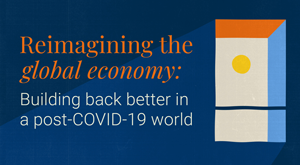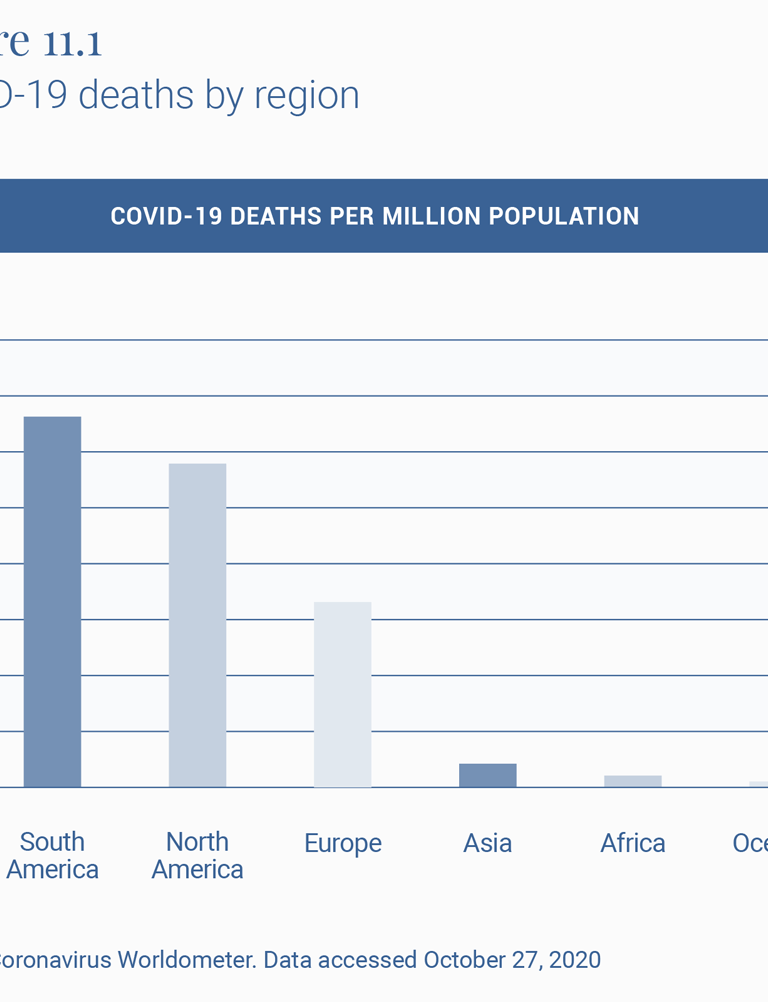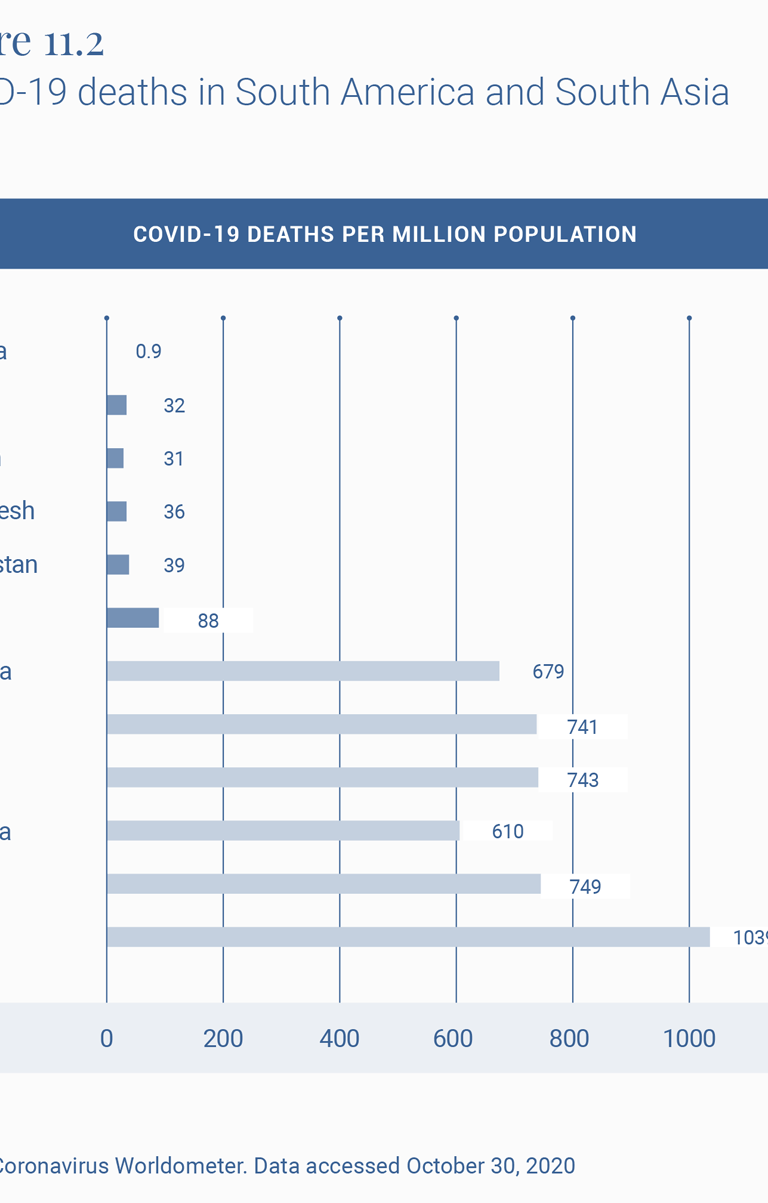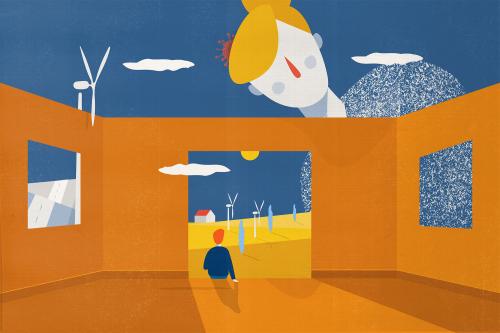This essay is part of “Reimagining the global economy: Building back better in a post-COVID-19 world,” a collection of 12 essays presenting new ideas to guide policies and shape debates in a post-COVID-19 world.
 The issue
The issue
The COVID-19 pandemic has exposed the inadequacy of public health systems worldwide, casting a shadow that we could not have imagined even a year ago. As the fog of confusion lifts and we begin to understand the rudiments of how the virus behaves, the end of the pandemic is nowhere in sight. The number of cases and the deaths continue to rise. The latter breached the 1 million mark a few weeks ago and it looks likely now that, in terms of severity, this pandemic will surpass the Asian Flu of 1957-58 and the Hong Kong Flu of 1968-69.
Moreover, a parallel problem may well exceed the direct death toll from the virus. We are referring to the growing economic crises globally, and the prospect that these may hit emerging economies especially hard.
The economic fall-out is not entirely the direct outcome of the COVID-19 pandemic but a result of how we have responded to it—what measures governments took and how ordinary people, workers, and firms reacted to the crisis. The government activism to contain the virus that we saw this time exceeds that in previous such crises, which may have dampened the spread of the COVID-19 but has extracted a toll from the economy.
This essay takes stock of the policies adopted by governments in emerging economies, and what effect these governance strategies may have had, and then speculates about what the future is likely to look like and what we may do here on.
Nations that build walls to keep out goods, people and talent will get out-competed by other nations in the product market.
The ideas
It is becoming clear that the scramble among several emerging economies to imitate and outdo European and North American countries was a mistake. We get a glimpse of this by considering two nations continents apart, the economies of which have been among the hardest hit in the world, namely, Peru and India. During the second quarter of 2020, Peru saw an annual growth of -30.2 percent and India -23.9 percent. From the global Q2 data that have emerged thus far, Peru and India are among the four slowest growing economies in the world. Along with U.K and Tunisia these are the only nations that lost more than 20 percent of their GDP.1
COVID-19-related mortality statistics, and, in particular, the Crude Mortality Rate (CMR), however imperfect, are the most telling indicator of the comparative scale of the pandemic in different countries. At first glance, from the end of October 2020, Peru, with 1039 COVID-19 deaths per million population looks bad by any standard and much worse than India with 88. Peru’s CMR is currently among the highest reported globally.
However, both Peru and India need to be placed in regional perspective. For reasons that are likely to do with the history of past diseases, there are striking regional differences in the lethality of the virus (Figure 11.1). South America is worse hit than any other world region, and Asia and Africa seem to have got it relatively lightly, in contrast to Europe and America. The stark regional difference cries out for more epidemiological analysis. But even as we await that, these are differences that cannot be ignored.
To understand the effect of policy interventions, it is therefore important to look at how these countries fare within their own regions, which have had similar histories of illnesses and viruses (Figure 11.2). Both Peru and India do much worse than the neighbors with whom they largely share their social, economic, ecological and demographic features. Peru’s COVID-19 mortality rate per million population, or CMR, of 1039 is ahead of the second highest, Brazil at 749, and almost twice that of Argentina at 679.
Similarly, India at 88 compares well with Europe and the U.S., as does virtually all of Asia and Africa, but is doing much worse than its neighbors, with the second worst country in the region, Afghanistan, experiencing less than half the death rate of India.
The official Indian statement that up to 78,000 deaths2 were averted by the lockdown has been criticized3 for its assumptions. A more reasonable exercise is to estimate the excess deaths experienced by a country that breaks away from the pattern of its regional neighbors. So, for example, if India had experienced Afghanistan’s COVID-19 mortality rate, it would by now have had 54,112 deaths. And if it had the rate reported by Bangladesh, it would have had 49,950 deaths from COVID-19 today. In other words, more than half its current toll of some 122,099 COVID-19 deaths would have been avoided if it had experienced the same virus hit as its neighbors.
What might explain this outlier experience of COVID-19 CMRs and economic downslide in India and Peru? If the regional background conditions are broadly similar, one is left to ask if it is in fact the policy response that differed markedly and might account for these relatively poor outcomes.
Peru and India have performed poorly in terms of GDP growth rate in Q2 2020 among the countries displayed in Table 2, and given that both these countries are often treated as case studies of strong governance, this draws attention to the fact that there may be a dissonance between strong governance and good governance.
The turnaround for India has been especially surprising, given that until a few years ago it was among the three fastest growing economies in the world. The slowdown began in 2016, though the sharp downturn, sharper than virtually all other countries, occurred after the lockdown.
On the COVID-19 policy front, both India and Peru have become known for what the Oxford University’s COVID Policy Tracker4 calls the “stringency” of the government’s response to the epidemic. At 8 pm on March 24, 2020, the Indian government announced, with four hours’ notice, a complete nationwide shutdown. Virtually all movement outside the perimeter of one’s home was officially sought to be brought to a standstill. Naturally, as described in several papers, such as that of Ray and Subramanian,5 this meant that most economic life also came to a sudden standstill, which in turn meant that hundreds of millions of workers in the informal, as well as more marginally formal sectors, lost their livelihoods.
In addition, tens of millions of these workers, being migrant workers in places far-flung from their original homes, also lost their temporary homes and their savings with these lost livelihoods, so that the only safe space that beckoned them was their place of origin in small towns and villages often hundreds of miles away from their places of work.
After a few weeks of precarious living in their migrant destinations, they set off, on foot since trains and buses had been stopped, for these towns and villages, creating a “lockdown and scatter” that spread the virus from the city to the town and the town to the village. Indeed, “lockdown” is a bit of a misnomer for what happened in India, since over 20 million people did exactly the opposite of what one does in a lockdown. Thus India had a strange combination of lockdown some and scatter the rest, like in no other country. They spilled out and scattered in ways they would otherwise not do. It is not surprising that the infection, which was marginally present in rural areas (23 percent in April), now makes up some 54 percent of all cases in India.6
In Peru too, the lockdown was sudden, nationwide, long drawn out and stringent.7 Jobs were lost, financial aid was difficult to disburse, migrant workers were forced to return home, and the virus has now spread to all parts of the country with death rates from it surpassing almost every other part of the world.
As an aside, to think about ways of implementing lockdowns that are less stringent and geographically as well as functionally less total, an example from yet another continent is instructive. Ethiopia, with a COVID-19 death rate of 13 per million population seems to have bettered the already relatively low African rate of 31 in Table 1.8
We hope that human beings will emerge from this crisis more aware of the problems of sustainability.
The way forward
We next move from the immediate crisis to the medium term. Where is the world headed and how should we deal with the new world? Arguably, that two sectors that will emerge larger and stronger in the post-pandemic world are: digital technology and outsourcing, and healthcare and pharmaceuticals.
The last 9 months of the pandemic have been a huge training ground for people in the use of digital technology—Zoom, WebEx, digital finance, and many others. This learning-by-doing exercise is likely to give a big boost to outsourcing, which has the potential to help countries like India, the Philippines, and South Africa.
Globalization may see a short-run retreat but, we believe, it will come back with a vengeance. Nations that build walls to keep out goods, people and talent will get out-competed by other nations in the product market. This realization will make most countries reverse their knee-jerk anti-globalization; and the ones that do not will cease to be important global players. Either way, globalization will be back on track and with a much greater amount of outsourcing.
To return, more critically this time, to our earlier aside on Ethiopia, its historical and contemporary record on tampering with internet connectivity9 in an attempt to muzzle inter-ethnic tensions and political dissent will not serve it well in such a post-pandemic scenario. This is a useful reminder for all emerging market economies.
We hope that human beings will emerge from this crisis more aware of the problems of sustainability. This could divert some demand from luxury goods to better health, and what is best described as “creative consumption”: art, music, and culture.10 The former will mean much larger healthcare and pharmaceutical sectors.
But to take advantage of these new opportunities, nations will need to navigate the current predicament so that they have a viable economy once the pandemic passes. Thus it is important to be able to control the pandemic while keeping the economy open. There is some emerging literature11 on this, but much more is needed. This is a governance challenge of a kind rarely faced, because the pandemic has disrupted normal markets and there is need, at least in the short run, for governments to step in to fill the caveat.
Emerging economies will have to devise novel governance strategies for doing this double duty of tamping down on new infections without strident controls on economic behavior and without blindly imitating Europe and America.
Here is an example. One interesting opportunity amidst this chaos is to tap into the “resource” of those who have already had COVID-19 and are immune, even if only in the short-term—we still have no definitive evidence on the length of acquired immunity. These people can be offered a high salary to work in sectors that require physical interaction with others. This will help keep supply chains unbroken. Normally, the market would have on its own caused such a salary increase but in this case, the main benefit of marshaling this labor force is on the aggregate economy and GDP and therefore is a classic case of positive externality, which the free market does not adequately reward. It is more a challenge of governance. As with most economic policy, this will need careful research and design before being implemented. We have to be aware that a policy like this will come with its risk of bribery and corruption. There is also the moral hazard challenge of poor people choosing to get COVID-19 in order to qualify for these special jobs. Safeguards will be needed against these risks. But we believe that any government that succeeds in implementing an intelligently-designed intervention to draw on this huge, under-utilized resource can have a big, positive impact on the economy12.
This is just one idea. We must innovate in different ways to survive the crisis and then have the ability to navigate the new world that will emerge, hopefully in the not too distant future.
Note: We are grateful for financial support from Cornell University’s Hatfield Fund for the research associated with this paper. We also wish to express our gratitude to Homi Kharas for many suggestions and David Batcheck for generous editorial help.
-
Footnotes
- “GDP Annual Growth Rate – Forecast 2020-2022,” Trading Economics, https://tradingeconomics.com/forecast/gdp-annual-growth-rate.
- “Government Cites Various Statistical Models, Says Averted Between 1.4 Million-2.9 Million Cases Due To Lockdown,” Business World, May 23, 2020, www.businessworld.in/article/Government-Cites-Various-Statistical-Models-Says-Averted-Between-1-4-million-2-9-million-Cases-Due-To-Lockdown/23-05-2020-193002/.
- Suvrat Raju, “Did the Indian lockdown avert deaths?” medRxiv, July 5, 2020, https://europepmc.org/article/ppr/ppr183813#A1.
- “COVID Policy Tracker,” Oxford University, https://github.com/OxCGRT/covid-policy-trackert.
- Debraj Ray and S. Subramanian, “India’s Lockdown: An Interim Report,” NBER Working Paper, May 2020, https://www.nber.org/papers/w27282.
- Gopika Gopakumar and Shayan Ghosh, “Rural recovery could slow down as cases rise, says Ghosh,” Mint, August 19, 2020, https://www.livemint.com/news/india/rural-recovery-could-slow-down-as-cases-rise-says-ghosh-11597801644015.html.
- Pierina Pighi Bel and Jake Horton, “Coronavirus: What’s happening in Peru?,” BBC, July 9, 2020, https://www.bbc.com/news/world-latin-america-53150808.
- “No lockdown, few ventilators, but Ethiopia is beating Covid-19,” Financial Times, May 27, 2020, https://www.ft.com/content/7c6327ca-a00b-11ea-b65d-489c67b0d85d.
- Cara Anna, “Ethiopia enters 3rd week of internet shutdown after unrest,” Washington Post, July 14, 2020, https://www.washingtonpost.com/world/africa/ethiopia-enters-3rd-week-of-internet-shutdown-after-unrest/2020/07/14/4699c400-c5d6-11ea-a825-8722004e4150_story.html.
- Patrick Kabanda, The Creative Wealth of Nations: Can the Arts Advance Development? (Cambridge: Cambridge University Press, 2018).
- Guanlin Li et al, “Disease-dependent interaction policies to support health and economic outcomes during the COVID-19 epidemic,” medRxiv, August 2020, https://www.medrxiv.org/content/10.1101/2020.08.24.20180752v3.
- For helpful discussion concerning this idea, we are grateful to Turab Hussain, Daksh Walia and Mehr-un-Nisa, during a seminar of South Asian Economics Students’ Meet (SAESM).









